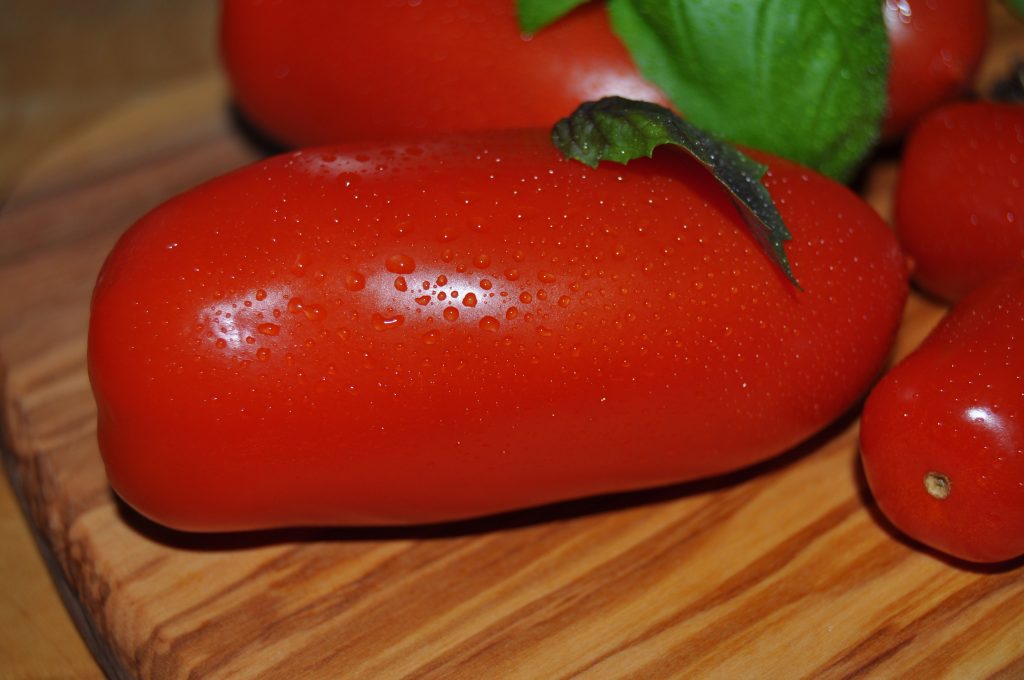If one visits the small town of San Marzano sul Sarno in late summer, one can smell the aromas of cooked tomatoes in the air: Late summer marks the beginning of the San Marzano tomato harvest season, and farmers are busy boiling down the freshly harvested tomatoes as quickly as possible and canning them to be exported all over the world. The San Marzano tomato has experienced a renaissance in recent years: in the nineties it was an endangered tomato variety, but today it is the basis for numerous recipes with tomatoes and is appreciated by amateur and professional chefs for its unique aroma.
What is the story behind what is perhaps Italy’s most aromatic tomato?
Home of the San Marzano tomato
It is the slopes around Mount Vesuvius where the San Marzano tomato is native: The tomato variety has its origins in European culture in the 18th century, when the first San Marzano plants were given to the King of Naples by the King of Peru and thus came to Europe. Legend also has it that the first San Marzano plants were planted around Mount Vesuvius. At that time, however, industrial cultivation was still a very distant prospect: even then, however, the variety was appreciated for its special spiciness and aroma. As a tomato variety that, according to legend, originated in South America, it also differs in shape from most other tomato varieties.
In 1991, the San Marzano tomato was even deleted from the catalog of varieties – so the tomato variety disappeared into insignificance.
Harvest
San Marzano tomatoes have a typical solid structure, are dark red in color, and have few seeds. In addition, a San Marzano tomato is elongated in shape.
Harvesting San Marzano tomatoes is particularly laborious: The delicacy of the tomato requires special care during harvest. In addition, San Marzano tomatoes ripen in batches from late July to late October. This means that the San Marzano tomato is harvested seven to eight times within these four months – manually harvesting every single tomato.
San Marzano tomatoes are excellent for canning: That’s why much of Italy’s San Marzano tomato production is canned. The delicate nature of the tomatoes prevents them from being transported over long distances. In addition, San Marzano tomatoes are always supposed to be harvested fully ripe. Italian San Marzano tomatoes can therefore rarely be found as fresh vegetables outside Italy.

Decline of the San Marzano variety
Around 1926, industrial cultivation of the San Marzano tomato began: For many decades, San Marzano tomatoes were sold simply as roma tomatoes – the elongated shape of the tomato variety was simply considered a visual conspicuousness of one among many subspecies.
In the eighties, numerous San Marzano plants around Mount Vesuvius fell victim to various diseases: since the San Marzano tomato was difficult to process anyway, other tomato varieties that were less demanding came to the fore. At that time, the San Marzano variety was far from having the reputation it enjoys today.
In 1991, the San Marzano tomato was even deleted from the catalog of varieties – so the tomato variety disappeared into insignificance.
Vesuvius
The name San Marzano comes from the Italian town of San Marzano sul Sarno in the province of Campania: The region around San Marzano sul Sarno, shaped by the volcanic soils of Mount Vesuvius, is known not least for its winegrowing. The nearest major city nearby is Salerno, and historic Pompeii is also not far away. However, it is not known whether the people of Pompeii knew about the legendary tomato variety almost two thousand years ago.
However, the soils around Mount Vesuvius were considered fertile even then, making them ideal for growing vines and tomatoes alike: Despite the constant danger of eruption, people settled there long ago and benefited from the fertility of the soil.
It wasn’t long ago that the San Marzano tomato was an endangered tomato variety.
Recipes with San Marzano tomatoes
The San Marzano tomato enjoys the status of Protected Designation of Origin: the full name is Pomodoro San Marzano dell’Agro Sarnese Nocerino D.O.P. Agro Sarnese Nocerino is a region in the province of Salerno.
San Marzano tomatoes play a major role in many Italian dishes: An original pizza sauce benefits from the particular flavor of the San Marzano tomato. Often, in recipes for an original Neapolitan pizza, you will find the indication to use San Marzano tomatoes for the sauce: The fact that the tomatoes are harvested at full ripeness and cooked down ensures a particularly strong aroma. The taste of a Neapolitan pizza is largely determined by the flavor of its tomato sauce: after all, the original pizza did not have a wide variety of toppings, but was simply spread with tomato sauce and topped with mozzarella.
It wasn’t long ago that the San Marzano tomato was an endangered tomato variety: since each tomato must be harvested by hand, its cultivation fell victim to the industrialization of Italy’s tomato fields.
It was not until a San Marzano plant could be bred that was immune to common tomato diseases that tomato growers in Italy again seriously considered cultivating the San Marzano tomato.
An Italian San Marzano tomato grows on the fertile volcanic soils on the edge of Mount Vesuvius, gets a lot of southern Italy’s intense sun and some of the fresh sea air in Campania.
Cover picture: © Simon von Ludwig

 Deutsch
Deutsch